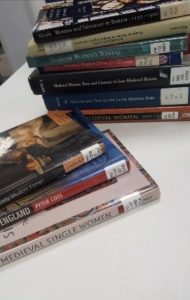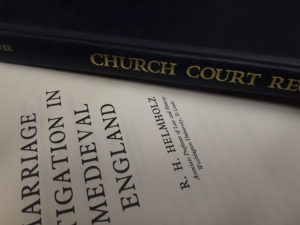This post was written by a group of undergraduate students from the University of Southampton who recently visited the IHR library to complete a research project. We are happy to welcome students doing group projects to the IHR, so please get in touch if you would like to arrange something similar.
 We are second year History undergraduate students studying at the University of Southampton, currently undertaking a group project titled ‘Thou art a fals preestes whore’- The Medieval English Church Courts, with a focus on the treatment and role of women within these courts. In order to complete our research on such a wide-ranging area of study, we travelled to the Institute of Historical Research hoping to find a greater collection of sources and literature than is available to us locally in Southampton.
We are second year History undergraduate students studying at the University of Southampton, currently undertaking a group project titled ‘Thou art a fals preestes whore’- The Medieval English Church Courts, with a focus on the treatment and role of women within these courts. In order to complete our research on such a wide-ranging area of study, we travelled to the Institute of Historical Research hoping to find a greater collection of sources and literature than is available to us locally in Southampton.
The institute was very happy to grant us admission and give us access to collections relevant to our research, and were extremely helpful in assisting us in the process. As we are all currently based in Southampton, we decided to take advantage of the Institute’s online catalogue which was both informative and easy to navigate, so we could optimise our time spent in the library reading the material rather than searching the collection.
Predominantly, our research covers the medieval period, but increasing material we found pointed to the 17th century onwards, so we decided to comment on the change of treatment of women by the courts from the Medieval period into early Modern. Whilst we all concluded that women were not on an equal playing field to men for a variety of reasons, our research does conclude that despite this, women enjoyed more rights than we originally assumed when beginning the project.
Women and Church Courts in Medieval England
English Church Courts in the Middle Ages stood as a pillar of most communities, under a far less power centralised state than we have today. This meant that the ruling of a Church Court could be damning to your position in society, particularly in more rural locations as communities tended to be smaller and more isolated. The existence of Church courts also spanned over a large period, stretching all the way to the eighteen-fifties, when the final ecclesiastical courts were given over to state courts. By the end of the eighteenth century the Church Courts had lost almost all power in the legal process but it was not until the mid-nineteenth century that there were reforms. It was actually matrimonial matters which were the last to be transferred, moved to the newly created Divorce Court. It can be seen that in fact there was a decline in Church Court’s jurisdiction since the Reformation of the sixteenth century, as Henry VIII ruled out the use of Papal law in favour of Roman Civil law. Although the ecclesiastical courts survived this change, it did mark a change in tradition and to most the end of the medieval period. Therefore, it is interesting to consider cases from within and beyond the Middle Ages to discuss if there is change not only in the outcome of the trials but also the impact of their ruling on people in society. Our research focuses on women, typically seen as more vulnerable members of society, evaluating whether changes in Church jurisdiction affected them.
The most important part of establishing our project and our argument was looking at primary sources, as without Latin at our disposal, we obtained these mainly in translation within secondary source books. Here are some of the books that we studied during our time at the IHR and how they helped us to develop our project further. This is just a small sample of our research:
 One book that was useful for our project from the IHR was Anne Tarver’s Church Court Records: An Introduction for Family and Local Historians, (Chichester: Phillimore, 1995). Tarver’s chapter on marriage was particularly helpful due to the clear breakdown of areas the church courts dealt with: contracts, divorce, conjugal rights and jactitation. Whilst the book exceeds our time period, Tarver comments on changes into the nineteenth century and includes relevant primary evidence. A particularly interesting case that Tarver mentions is one of servant, Cordelia Ball, who gives a statement witnessing the cruelty of her master Andrew Dunton to his wife. She suggests to witnessing physical and verbal abuse. (p. 90) The fact that a servant should be called as witness is something we have found to have been a regular occurrence in the Middle Ages to provide evidence in court, so despite going beyond the medieval period it demonstrates that the workings and dealings with church courts actually remained rather similar. As with many sources the issue we have found is a lack of conclusion, as many sources have been damaged, lost or not complete in their recording, which we have had to take into consideration when evaluating these sources.
One book that was useful for our project from the IHR was Anne Tarver’s Church Court Records: An Introduction for Family and Local Historians, (Chichester: Phillimore, 1995). Tarver’s chapter on marriage was particularly helpful due to the clear breakdown of areas the church courts dealt with: contracts, divorce, conjugal rights and jactitation. Whilst the book exceeds our time period, Tarver comments on changes into the nineteenth century and includes relevant primary evidence. A particularly interesting case that Tarver mentions is one of servant, Cordelia Ball, who gives a statement witnessing the cruelty of her master Andrew Dunton to his wife. She suggests to witnessing physical and verbal abuse. (p. 90) The fact that a servant should be called as witness is something we have found to have been a regular occurrence in the Middle Ages to provide evidence in court, so despite going beyond the medieval period it demonstrates that the workings and dealings with church courts actually remained rather similar. As with many sources the issue we have found is a lack of conclusion, as many sources have been damaged, lost or not complete in their recording, which we have had to take into consideration when evaluating these sources.
R.H. Helmholz’ book Marriage Litigation in Medieval England (Cambridge:Cambridge University Press, 1974) gives an overview of particular aspects of marriage litigation including marriage records, divorce cases and witnesses used within the English Church Courts. Helmholz summarises records and provides statistics that clearly summarise the amount of cases in specific areas across England. For example, ‘at Lichfield between 1465 and 1468, suits brought to establish the existence of valid marriages outnumbered suits for divorce by a margin of thirty to fifteen.’ (p. 11) Comparisons such as this helped to summarise the vast amount of marriage records and explain how these related to other cases the courts dealt with such as divorce or impotence. Helmholz mentions the case of Edmund Dronefeld of York from 1364 who appealed to divorce his wife Margaret due to the belief she was married to another man eighteen years prior, making their current marriage void (p. 77). This was helpful as he cites the original York Cause Paper record, meaning it was easy to corroborate the primary evidence to Helmholz’ writing, especially as this database has recently been uploaded online for easy access.
These previously discussed sources, along with others and our extended research, we concluded that across areas of marriage, impotency, prostitution and heresy, women were at a clear disadvantage in church court cases as they were seen as less reputable than male defendants. Although the change in jurisdiction that church courts held after the reformation may have affected their ability and the impact of a case’s outcome, the church courts were not fully disbanded until the eighteen-fifties and still held an element of power but with a definitive decline. However, in many cases we have come across, church courts in fact provided an environment in which women could express their opinions and challenge men, with higher status women affording male lawyers prosecuting on their behalf. Even if a case did not go in favour of the woman, having a platform in which to defend themselves publicly was an achievement in itself, especially in a period where women often were limited to a domestic sphere.
This is only a small extract from a much wider project and if interested please visit our website to explore women and their role and treatment in English medieval church courts further at: churchcourts.co.uk
